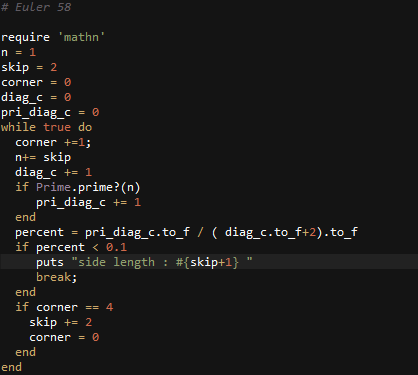http://projecteuler.net/problem=27
Considering quadratics of the form:
n² + an + b, where |a| < 1000 and |b| < 1000
where |n| is the modulus/absolute value of n
e.g. |11| = 11 and |-4| = 4
Find the product of the coefficients, a and b, for the quadratic expression that produces the maximum number of primes for consecutive values of n, starting with n = 0.
static void Main(string[] args)
{
//n² + an + b
int maxprimes = 0;
int maxproduct = 0;
for (int a = 0; a < 1000; a++)
{
for (int b = 0; b < 1000; b++)
{
int prime = countPrime(a, b);
if (maxprimes < prime)
{
maxprimes = prime;
maxproduct= (-a*b );
}
}
}
Console.WriteLine(maxproduct);
}
public static int countPrime(int a, int b)
{
int count = 0;
int n = 0;
while (true)
{
double result = Math.Pow(n, 2.00) - (a * n) + b;
if (isPrime((int)result) && result >= 0)
count++;
else
return count;
n++;
}
}
public static bool isPrime(int n)
{
if (n == 1)
return false;
if (n == 2)
return true;
for (int i = 2; i < n; ++i)
{
if ((n % i) == 0)
return false;
}
return true;
} |
static void Main(string[] args)
{
//n² + an + b
int maxprimes = 0;
int maxproduct = 0;
for (int a = 0; a < 1000; a++)
{
for (int b = 0; b < 1000; b++)
{
int prime = countPrime(a, b);
if (maxprimes < prime)
{
maxprimes = prime;
maxproduct= (-a*b );
}
}
}
Console.WriteLine(maxproduct);
}
public static int countPrime(int a, int b)
{
int count = 0;
int n = 0;
while (true)
{
double result = Math.Pow(n, 2.00) - (a * n) + b;
if (isPrime((int)result) && result >= 0)
count++;
else
return count;
n++;
}
}
public static bool isPrime(int n)
{
if (n == 1)
return false;
if (n == 2)
return true;
for (int i = 2; i < n; ++i)
{
if ((n % i) == 0)
return false;
}
return true;
}
1; it contains exactly 2,098,960 digits. Subsequently other Mersenne primes, of the form 2p
1, have been found which contain more digits.
27830457+1.










